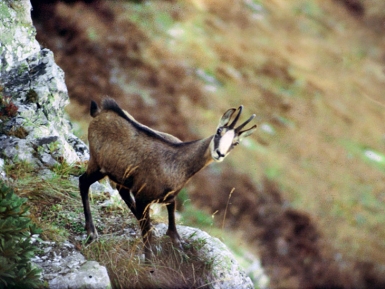Posted 07/28/11
Protected area effectiveness is a major question in Conservation Biology today. Eugenia will use state-of-the-art remote sensing analyses to focus on land cover change in Russian nature reserves. She will also use two long term animal population datasets: Chronicles of Nature, which are historical records of animal populations collected in each nature reserve in Russia, and Winter Track Count, which are long-term surveys of game species throughout Russia. These datasets, paired with the land cover changes, will allow her to study the relationship between land cover change and animal populations in a geographic region and at a scale that has not yet been performed.
Protected area effectiveness is a major question in Conservation Biology today. Eugenia will use state-of-the-art remote sensing analyses to focus on land cover change in and near Russian nature reserves. Satellite data will allow her to study the relationship between land cover change and protected area effectiveness in a geographic region and at a scale that has not yet been performed.

A major question in Conservation Biology today is ‘What are effective strategies to conserve biodiversity?’ One major strategy used is to protect areas, such as national parks and nature reserves, and the total area that is protected has expanded at a rapid rate throughout the world in the last 30 years. But the reviews are mixed as to whether protected areas are always effective at protecting the habitat and the wildlife for which they have been created. To add a valuable perspective to this important conservation issue, Eugenia (Genya) Bragina arrived in Madison in Spring 2011 to start an exciting new project to study land cover change in and around nature reserves throughout Russia.Genya will focus on land cover change in Russian nature reserves, which is a region that is yet to be investigated by scientists studying the protected area issue. Specifically, Genya will examine the Kavkaskzy Nature Reserve, which is one of the premiere protected areas in the Caucasus Mountains. The Caucasus mountains is especially important biologically because it is home to a wide variety of endemic species. These mountains were habitat refugia for a diversity of species during the last glaciation, and many of these species survived and persisted to the present day only in the Caucasus Mountains. It is rich with old-growth forest and several threatened species, such as tur, chamois, lynx, wildcat, bear, wolves, endemic raptors, deer, and several species of owls, raptors, and forest birds.Genya will focus on land cover change in Russian nature reserves, which is a region that is yet to be investigated by scientists studying the protected area issue. The reserve was established more than 100 years ago, as hunting grounds for the grand dukes. But increasingly, the unique habitat and animals of the Caucasus region are vulnerable to land cover change, poaching, and disturbance from tourism. Extensive land cover change, such as logging, has been documented outside of the reserve, but it is uncertain whether similar processes have occurred inside the reserve. In addition, tourism and its side effects are a growing threat — the border area of the Kavkaskzy Nature Reserve will be home to the 2014 Winter Olympics, and development of the area to accommodate mass tourism has already begun.

The Kavkaskzy Nature Reserve’s greatest natural treasure are large patches of primary forest. Fragmentation of these forests is especially detrimental for wildcats, owls, and old-growth forest songbirds. Genya’s first goal is to measure forest disturbance in and around the Kavkaskzy nature reserve to understand whether the reserve has effectively protected the forests of the nature reserve.

Second, Genya will look at what is going on outside of the nature reserve. Studies by other members of the SILVIS lab show that agricultural abandonment is extensive throughout Eastern Europe since the breakup of the Soviet Union. However, patterns are widely variable from region to region, which has important implications for biodiversity (for example see: https://russell-silvis.dev.webhosting.cals.wisc.edu/research/story/Post-USSR-Land-Cover-Change-Eastern-Europe-%E2%80%93-Socioeconomic-Forcings-Effects). Genya will measure agricultural abandonment in the Caucasus region to see if the land use patterns look promising for biodiversity.Genya’s research is exciting to the conservation community and the ecology community. She will fill a major gap in our knowledge about the effectiveness of protected areas in Russia. She will give us insight into the relationships between land cover change and protected areas in a way that has not yet been done.

“
Story by Radeloff, Volker
